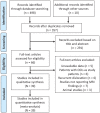Prevalence and Site of Concomitant Osteochondral Injuries in Patients With Acute Lateral Patellar Dislocation: A Systematic Review and Meta-analysis
- PMID: 38274015
- PMCID: PMC10809874
- DOI: 10.1177/23259671231220904
Prevalence and Site of Concomitant Osteochondral Injuries in Patients With Acute Lateral Patellar Dislocation: A Systematic Review and Meta-analysis
Abstract
Background: Osteochondral injuries (OCIs) are common in patients with acute lateral patellar dislocation, which can produce both short- and long-;term adverse effects. However, the pattern of these injuries warrants further analysis, especially in relation to patient age.
Purpose: To determine the overall prevalence of concomitant OCIs as well as the prevalence differences based on location and age after acute lateral patellar dislocations.
Study design: Systematic review; Level of evidence, 4.
Methods: A comprehensive search of PubMed, Embase, Web of Science, and Cochrane Library was completed from inception to July 20, 2022. All articles reporting the prevalence of OCI were included. The sample characteristics such as age, study design, magnetic resonance imaging diagnostic data, and the number of patients with OCI were extracted. The Methodological Index for Non-Randomized Studies (MINORS) was used for quality assessment. The overall and per-;site injury rates were calculated, and the prevalence was stratified by age-;group (≤16 and >16 years) and compared.
Results: The systematic review included 39 studies involving 3354 patients. MINORS scores were 11.94 ± 1.98 and 16 ± 3.46 in the noncomparative and comparative studies, respectively. The overall prevalence of bone bruises and OCI was 89.6% (95% CI, 77.4%-97.7%) and 48.8% (95% CI, 39.0%-58.7%), respectively. In both overall and >16-year-old patients, the lateral femoral condyle (LFC) was the most common site of bone bruise (90.5% [95% CI, 84.0%-95.6%] and 91.5% [95% CI, 84.3%-96.9%], respectively); however, the medial patellar bruise was more common in patients ≤16 years (89.2% [95% CI, 82.9%-94.4%]). Among the pooled sites of OCI, the medial patella accounted for the largest proportion (36.9% [95% CI, 28.0%-46.3%]). OCIs were more common in patients >16 years (52.6% [95% CI, 39.4%-65.6%]) than in patients ≤16 years (46.6% [95% CI, 33.2%-60.3%]).
Conclusion: Bone bruises on the LFC were most prevalent overall and in patients >16 years, whereas bone bruises on the medial patella were more prevalent in patients ≤16 years. OCIs were frequently seen in patients >16 years, with the most common site being the medial patella.
Keywords: acute lateral patellar dislocation; bone bruises; osteochondral.
© The Author(s) 2024.
Conflict of interest statement
One or more of the authors has declared the following potential conflict of interest or source of funding: Research support was received from the National Natural Science Foundation of China (81874017, 81960403, and 82060405); Lanzhou Science and Technology Plan Program (2021-RC-102); Natural Science Foundation of Gansu Province (22JR5RA943, 22JR5RA956); and the Cuiying Scientific and Technological Innovation Program of Lanzhou University Second Hospital (CY2020-BJ03, CY2021-MS-B02, and CY2021-MS-A07). AOSSM checks author disclosures against the Open Payments Database (OPD). AOSSM has not conducted an independent investigation on the OPD and disclaims any liability or responsibility relating thereto.
Figures



References
-
- Ahmad CS, Shubin Stein BE, Matuz D, Henry JH. Immediate surgical repair of the medial patellar stabilizers for acute patellar dislocation: a review of eight cases. Am J Sports Med. 2000;28(6):804-810. - PubMed
-
- Askenberger M, Arendt EA, Ekström W, et al.. Medial patellofemoral ligament injuries in children with first-;time lateral patellar dislocations: a magnetic resonance imaging and arthroscopic sStudy. Am J Sports Med. 2016;44(1):152-158. - PubMed
-
- Atkin DM, Fithian DC, Marangi KS, et al.. Characteristics of patients with primary acute lateral patellar dislocation and their recovery within the first 6 months of injury. Am J Sports Med. 2000;28(4):472-479. - PubMed
-
- Baker H, Dickherber J, Reddy M, et al.. Diagnostic value of MRI and radiographs of the knee to identify osteochondral lesions in acute patellar instability. J Knee Surg. 2022;35(14):1604-1609. - PubMed
LinkOut - more resources
Full Text Sources

